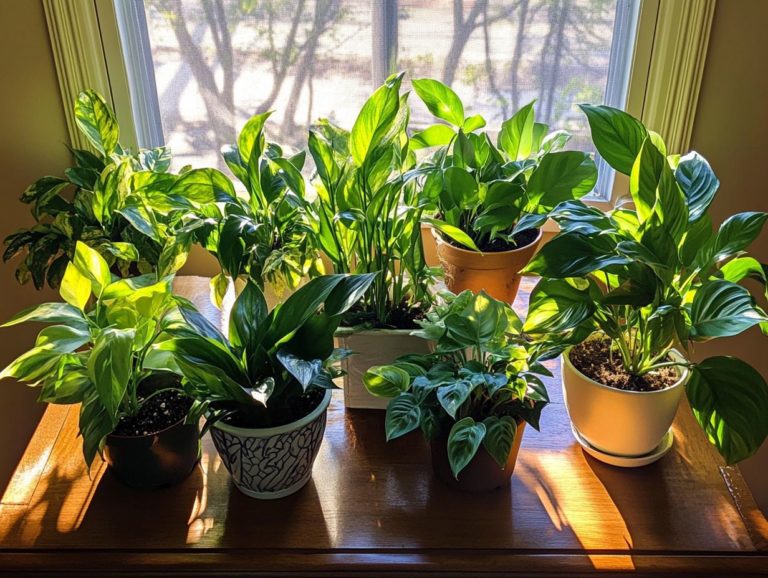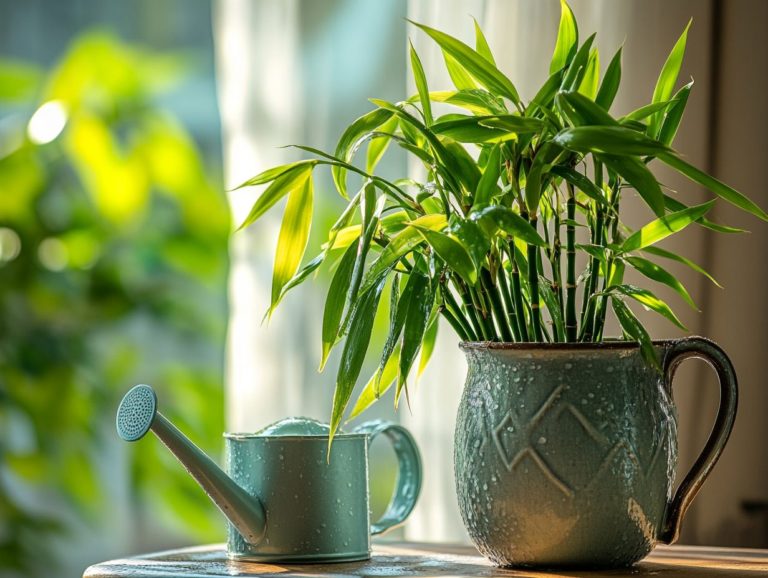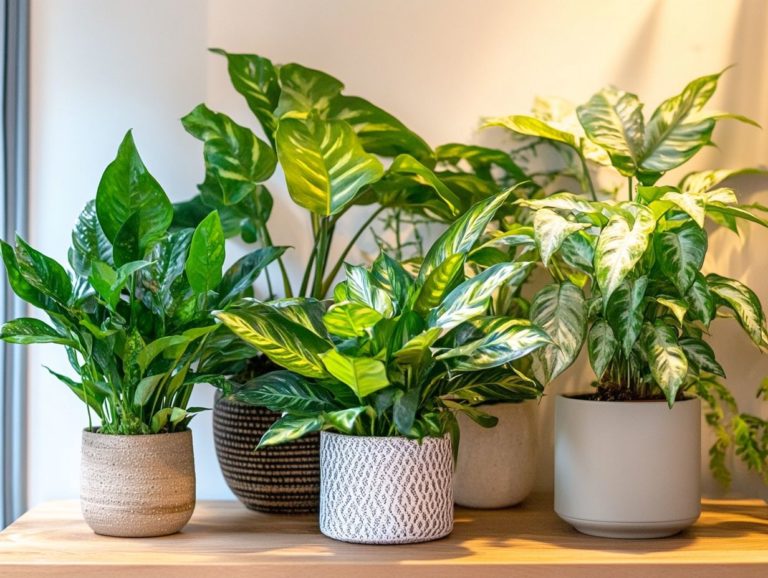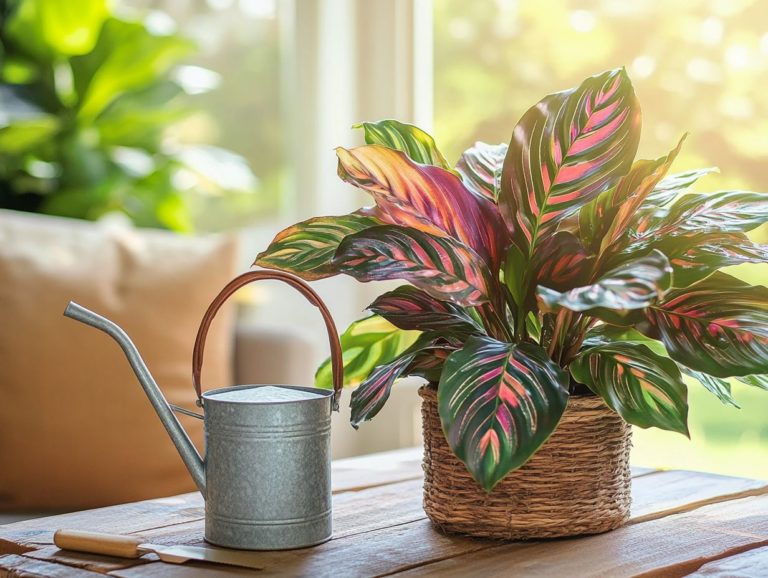Caring for Indoor Eucalyptus: A Guide
Indoor eucalyptus has emerged as a favored choice for those wishing to infuse their homes with a touch of vibrant greenery.
With its aromatic leaves and unique aesthetic, it offers more than just visual appeal; it s also relatively low-maintenance. However, selecting the right species and providing an ideal environment can present a few challenges.
This guide will walk you through every essential detail, from the optimal light and temperature requirements to effective watering, fertilizing, and pest management, ensuring that your indoor eucalyptus flourishes beautifully.
Get ready to create the perfect home for your indoor eucalyptus and watch it thrive in your space!
Contents
- Key Takeaways:
- Choosing the Right Eucalyptus Species
- Light and Temperature Requirements
- Watering and Fertilizing Eucalyptus
- Pruning and Maintenance
- Pests and Diseases
- Frequently Asked Questions
- Quick Tips
- What is the best way to care for an indoor eucalyptus plant?
- How often should I water my indoor eucalyptus plant?
- Can I prune my indoor eucalyptus plant?
- Should I repot my indoor eucalyptus plant?
- What are some common pests or diseases that can affect indoor eucalyptus plants?
- Can I use my indoor eucalyptus plant for cooking or medicinal purposes?
Key Takeaways:
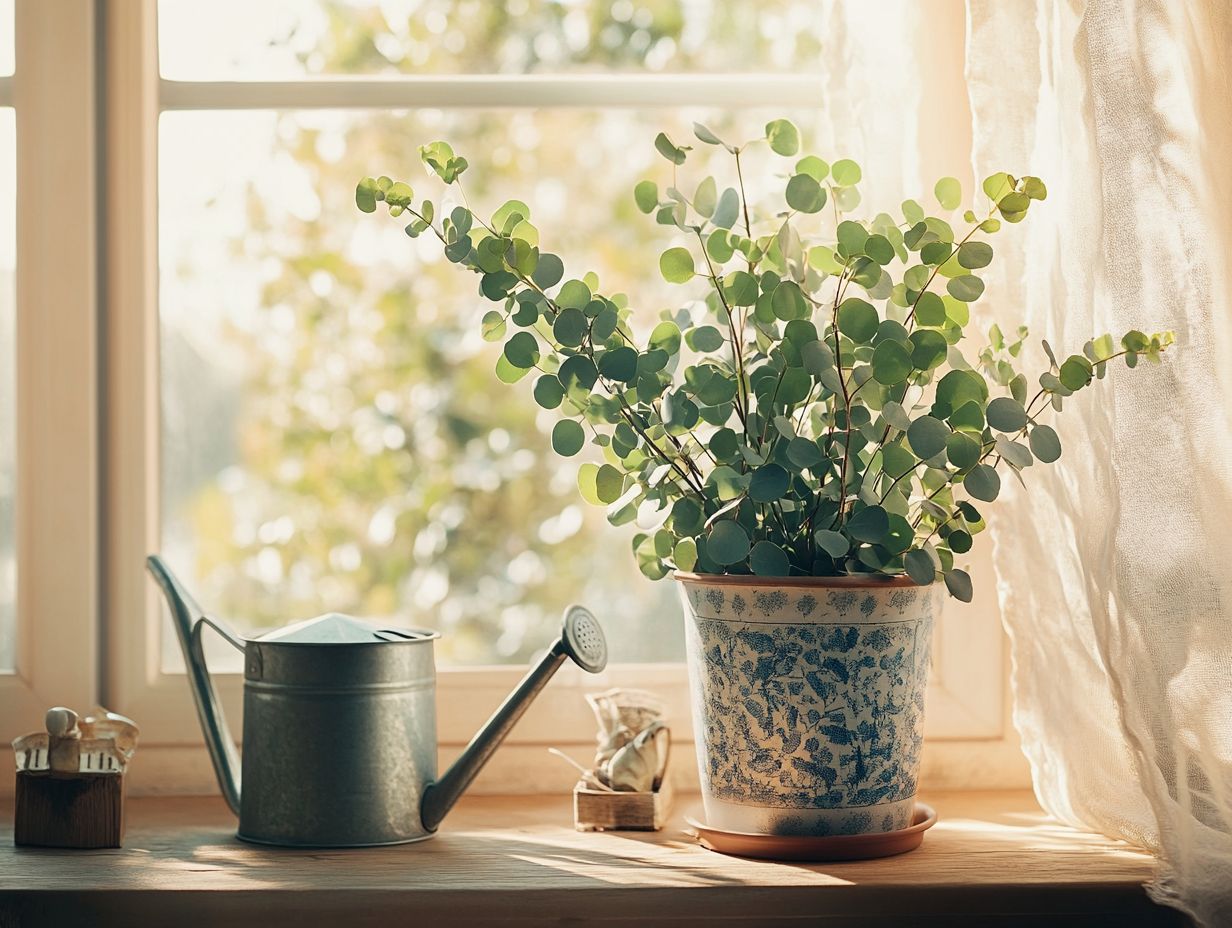
- Choose the right eucalyptus species for indoor care, considering factors like sunlight and temperature requirements.
- Proper watering techniques and choosing the right fertilizer are crucial for keeping indoor eucalyptus healthy and thriving.
- Regular pruning and maintenance tasks, as well as proper pest and disease identification and treatment, are essential steps for you to care for your indoor eucalyptus plants.
What is Indoor Eucalyptus?
Indoor eucalyptus refers to a range of eucalyptus plants specifically cultivated for your indoor spaces, blending aesthetic appeal with functionality as fragrant houseplants. Take, for example, the popular Eucalyptus cinerea.
Its aromatic leaves not only beautify your surroundings but can also be transformed into essential oils, infusing your home with a refreshing fragrance.
These plants thrive in well-draining soil and bask in bright light, making them perfect for those sunlit rooms or cozy corners.
Their growth habits lead to a striking appearance, showcasing delicate, silvery leaves that enhance your decor and provide numerous benefits.
Bringing indoor eucalyptus into your home can elevate air quality and reduce stress, thanks to their naturally soothing aroma. The essential oils extracted from the leaves are celebrated for their antiseptic properties, perfect for use in diffusers or crafting homemade cleaning products.
The calming scent they offer makes eucalyptus a delightful addition to any household, promoting wellness and tranquility.
Choosing the Right Eucalyptus Species
When selecting the ideal eucalyptus species for indoor cultivation, it’s essential to grasp the distinct needs and characteristics of different eucalyptus plants. Consider popular options like the Silver Dollar Tree and Eucalyptus globulus.
Key factors, such as hardiness zones (the climate zones in which a plant can grow), and growth patterns, are vital in ensuring the chosen species flourishes within your indoor space.
Factors to Consider
When choosing an indoor eucalyptus species, you must carefully consider several key factors, such as soil requirements, light conditions, temperature, and humidity levels. Understanding these elements is essential for ensuring that your selected eucalyptus plant thrives in its indoor environment and remains healthy throughout the seasons.
The ideal soil for eucalyptus is well-draining, as these plants flourish in types of soil that allow excess moisture to escape. A loamy or sandy mix enriched with organic matter will provide essential nutrients while preventing root rot.
Eucalyptus thrives best in full sunlight, ideally basking in 6 to 8 hours of direct light each day to promote robust growth.
Temperature is another vital factor; eucalyptus prefers a warm environment, ideally between 60 F and 75 F, to encourage healthy development.
Maintaining moderate humidity levels will support the plant in retaining its foliage and overall vitality, ensuring a flourishing indoor eucalyptus experience.
Light and Temperature Requirements
Light and temperature requirements are essential for the thriving growth of indoor eucalyptus, as these elements profoundly influence the plant’s health and vitality.
You ll find that eucalyptus trees flourish in bright sunlight and favor temperatures reminiscent of their native Australian habitats, which ultimately promotes optimal growth and development.
Providing Adequate Sunlight and Temperature

To ensure the proper growth of your eucalyptus, it’s essential to provide them with adequate sunlight and maintain temperature conditions that reflect their native habitat. These plants thrive in bright sunlight and do best when the temperature stays within their preferred range. For optimal growth, consider positioning your eucalyptus near south-facing windows. This allows them to bask in the maximum amount of light throughout the day. If natural light is limited, using grow lights can effectively supplement their needs, mimicking the intense sunlight they would naturally seek.
Stay vigilant about temperature fluctuations, aiming for a stable climate between 65 F to 75 F. Significant changes can impede their development. Using thermometers or temperature monitors helps you maintain these ideal conditions. This ensures your indoor garden thrives beautifully.
Watering and Fertilizing Eucalyptus
Watering and fertilizing are essential elements of eucalyptus care. They significantly impact the plant’s vitality and growth. By grasping the specific watering needs and the appropriate type of fertilizer for eucalyptus trees, you can ensure optimal maintenance of these fragrant houseplants.
Proper Watering Techniques
Proper watering techniques are crucial for keeping your eucalyptus thriving. These plants flourish in well-draining soil that prevents waterlogging and encourages robust root growth. By grasping the specific water needs of your eucalyptus, you can fine-tune its care routine for optimal health.
To effectively assess soil moisture, simply insert your finger about an inch into the soil; if it feels dry, it s time to water. For those who prefer precision, utilizing a moisture meter (a tool that measures how wet the soil is) can offer an accurate reading, ensuring your plant receives just the right amount of hydration. Crafting a potting mix that includes materials like perlite or sand can enhance drainage, reducing the risk of root rot.
It s vital to remember that overwatering is a common misstep. Allowing the top layer of soil to dry out between waterings can significantly boost the health of your eucalyptus. By closely monitoring these factors, you can create a lush and thriving environment for your greenery.
Choosing the Right Fertilizer
Selecting the right fertilizer for your eucalyptus is crucial for ensuring healthy growth and vibrant foliage. Opt for a balanced fertilizer that caters to the specific soil needs of eucalyptus plants. This choice can significantly enhance their overall development and delightful fragrance.
These evergreens thrive best in well-drained, nutrient-rich soil, so incorporating a mix of organic and chemical fertilizers will provide optimal support. Organic options like compost or well-rotted manure release nutrients gradually, promoting steady growth while minimizing the risk of over-fertilization. A water-soluble fertilizer offers quick access to essential nutrients, especially during the active growing season.
To determine the ideal dosage, follow the manufacturer s guidelines closely and keep an eye on your plant s response. Adjust the frequency of application according to its growth patterns and the environmental conditions that influence its maintenance.
Pruning and Maintenance
Pruning and maintenance are key to a thriving eucalyptus! They play a crucial role in shaping the plant’s growth while preventing potential issues like overcrowding or disease. By regularly pruning your eucalyptus species, you encourage vibrant, healthy growth that makes your eucalyptus shine! This also elevates the plant’s overall appearance and delightful fragrance.
Start caring for your eucalyptus today, and for additional tips, check out this comprehensive guide on caring for indoor peperomias, and watch your indoor garden flourish!
How to Prune Indoor Eucalyptus

Pruning indoor eucalyptus effectively requires a keen understanding of the right techniques and timing to foster healthy growth while maintaining an elegant shape. Regularly trimming your eucalyptus plants helps manage their size and improve air circulation, while also providing delightful opportunities to create new cuttings for propagation.
To get started, gather your essential tools: sharp pruning shears, a clean cloth for sterilization, and gloves to protect your hands from sap if you prefer. Before jumping into the process, assess the overall health of your plant. Look closely for any signs of disease or dead branches that need your immediate attention.
With your shears in hand, make clean cuts at a 45-degree angle, ensuring that each branch is snipped just above a leaf node to encourage fresh growth. You can help your eucalyptus thrive by routinely pruning during the growing season specifically in spring and early summer. This will ensure it remains a stunning addition to your indoor space.
Common Maintenance Tasks
Common maintenance tasks for your indoor eucalyptus include regular watering, fertilizing, pruning, and monitoring for potential issues related to pests and diseases. Being proactive ensures your indoor eucalyptus stays vibrant and free from common challenges.
Routine observation is essential. Keep an eye out for yellowing leaves, which may signal care issues, or wilting. Checking for signs of pests, such as spider mites or aphids, allows for timely intervention.
Create a care routine that includes regular watering, monitoring light exposure, and checking humidity levels. Ensuring bright sunlight for optimal growth is equally important, as these elements significantly influence health.
Regularly inspect the soil moisture and maintain well-draining soil. Proper drainage prevents root rot, a common concern for indoor varieties. By integrating these practices and following some indoor plant care tips for a decorative touch, you can enhance the overall health and vitality of your indoor eucalyptus.
Pests and Diseases
Discovering the pests and diseases that can impact your indoor eucalyptus can keep your plants thriving and healthy. Being aware of common eucalyptus challenges allows for effective management through proper maintenance and timely interventions.
Identifying and Treating Common Pests and Diseases
Identifying and addressing common pests and diseases in your indoor eucalyptus is essential for its longevity and vitality. By staying attuned to potential issues, you can take proactive steps to resolve problems before they escalate.
Keen observation is vital for effective eucalyptus maintenance. Signs like yellowing leaves, webbing caused by spider mites, or sticky residue may indicate infestations. Additionally, leaf spots or wilting could point to diseases like root rot or fungal infections.
Consider using organic insecticidal soaps for treating pests and maintaining the right humidity levels, as eucalyptus thrives in a balanced environment. Regularly inspecting your plant and ensuring good air circulation are crucial preventative measures.
By doing so, you significantly reduce the risk of infestations and diseases, setting the stage for your indoor eucalyptus to flourish beautifully as fragrant houseplants.
Frequently Asked Questions
Quick Tips
- Prune in spring and early summer.
- Keep soil well-draining to prevent root rot.
- Monitor for pests regularly.
- Ensure adequate light and humidity levels for growth.
Start caring for your eucalyptus today to enjoy its beauty and benefits!
What is the best way to care for an indoor eucalyptus plant?

To care for your indoor eucalyptus, place it in a bright spot. Water it regularly and ensure the soil drains well.
Use fertilizer once a month during the growing season for a healthy boost.
How often should I water my indoor eucalyptus plant?
Water your indoor eucalyptus every 1-2 weeks. Check the top 1-2 inches of soil; if it feels dry, it’s time for a drink!
Be careful not to overwater, as this can lead to root rot.
Can I prune my indoor eucalyptus plant?
Yes! Pruning helps maintain the health and shape of your plant. Trim off any dead or damaged leaves.
Also, cut back any long and thin branches to encourage new growth.
Should I repot my indoor eucalyptus plant?
If your eucalyptus is ready for a bigger home, it’s time to repot! Choose a pot that is 2-3 inches wider and ensure it has good drainage.
Spring is the best time for repotting.
What are some common pests or diseases that can affect indoor eucalyptus plants?
Indoor eucalyptus plants can attract pests like mealybugs, scale, and spider mites. They may also face fungal diseases such as powdery mildew.
Keeping the plant clean and pruning regularly can help prevent these issues.
Can I use my indoor eucalyptus plant for cooking or medicinal purposes?
While eucalyptus leaves are often used for medicinal purposes, it’s not safe to use leaves from indoor plants for consumption.
These plants may have been treated with pesticides or other harmful chemicals.

